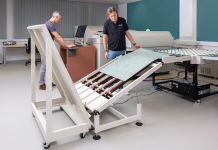François Martin, Graphics Industry and Communication Consultant, and writing for drupa, says that in the world of packaging there is a wave of changes on the horizon.
For decades, the packaging industry has operated behind the scenes, driven by the things we encounter every day, some of which rely on machinery and processes established over 50 years ago. The industry has recently stepped into the spotlight. While the saying ‘out of sight, out of mind’ has applied well to this industry, it is now facing significant changes that could have occurred independently but have now converged.
The convergence of conjunctural and structural elements is reshaping the packaging industry. While these elements may not fundamentally challenge an industry known for its resilience, they are compelling all players to embrace change.
Let’s start with the conjunctural elements that are evident and notably impacting profit margins, such as increase in energy and raw material prices. The significant price hikes, even when passed on to customers, are not sustainable in the long run. It is imperative for converters to implement energy-efficient production lines. Equally important is quality control and waste reduction. For machine manufacturers, after implementing notable price increases in 2021 and 2022, they now revamp their offering behind one simple motto: automation. We will look into this further later on.
Scarcity of labour and qualification of employees are other elements. The packaging industry remains relatively unknown to the general public. If we were to survey individuals with no professional or family ties to the industry, they would likely perceive it as a traditional and noisy sector. Furthermore, packaging is often seen as polluting and environmentally unfriendly. However, the advent of digital machinery and AI presents opportunities for packaging manufacturers to offer new careers and reshape their image to attract fresh talent.
The Structural Topics:
Proliferation Of Short Print Runs
The growth of short print runs is expected to accelerate in the coming years. Brands manage increasingly diverse product portfolios, and sales forecasting has become more complex. The concept of ‘on-demand production’ is becoming the norm. Additionally, promotional and event-based packaging, which often has a short lifespan, contributes to this trend. Furthermore, frequent regulatory changes require brands to update packaging information, necessitating new printing plates each time.
Evolving Role Of Packaging
Packaging is no longer just about protection; it plays a crucial role in enticing customers, informing consumers, and optimising the supply chain. As a result, new designs, customisation, QR codes and serialsation are becoming increasingly common. These new responsibilities lead to more sophisticated and ever-changing print runs, contributing to the reduction of run lengths across all types of packaging.
Design And Miniaturisation
Design is gaining increasing importance for consumers and brands alike. Appealing design attracts consumers, while miniaturisation reduces material consumption, environmental impact and costs. These trends require more frequent design iterations and higher-performing machines capable of producing more complex formats.
New Regulations
Brands and retailers are required to be transparent about the composition and origin of their packaging. Communication about materials used, recycled content and recyclability can render certain packaging types and the machines producing them obsolete. Many large brand owners made significant pledges towards recyclable packaging by 2025. The clock is ticking.
Environmental Responsibility
With growing concerns about the environmental impact of packaging, there is a shift from plastic to paper/cardboard and the development of new mono-component substrates for easier recycling. However, the challenge lies in the existence of recycling infrastructure. Packaging manufacturers need to implement industrial production processes capable of handling these new materials across coating, vacuum metallising, printing and lamination to the manufacture of final packages with proper sealing and opening features.
Combining the conjunctural and structural elements, it becomes apparent that the packaging industry will face numerous significant challenges. It must evolve to become more flexible, responsive and adaptive. In this context, what are the opportunities and upcoming changes?
Automation And Quality Control
The increasing trend towards automation allows for the reduction of scarce and costly skilled labour. It also helps minimise errors and waste. Machines equipped with quality control systems can rectify shortcomings or halt production. With the integration of AI, these systems will make significant progress, enabling machine operators to supervise multiple machines with very limited physical intervention.
Digitalisation
While the digitalisation of labelling has become prevalent, the folding carton, corrugated board and flexible packaging sectors are still relatively hesitant. However, the global threshold of 100 digital presses for corrugated board packaging was crossed by the end of 2022, indicating a shift towards digitalisation adoption. The overall packaging digital transformation extends beyond printing and encompasses embellishment and cutting such as Highcon, SEI Laser, MGI and Jetfx. Although current solutions may not yet match the productivity levels of conventional technologies, they are necessary to optimise overall production and allow conventional equipment to focus on what they are designed for, meaning medium and long print runs.
Digital technologies are an incredible tool, not a threat, and it will intelligently complement conventional technologies that will persist for decades. We will also see the rise of hybrid solutions combining the best of both worlds. Many label converters and commercial printing companies can testify to the advantages of digital technology. The adage ‘we fear what we do not know’ remains true in most industries.
Workflow Management
It has become the nerve centre of packaging manufacturers. From order placement to pre-press, production, quality control and invoicing, optimising the flow of production and processes and mastering workflow management are fundamental. Data-driven processes, leading to greater operational efficiency and optimised resource allocation are now required for faster-time to market and more flexibility. And the advent of AI will further enhance the power of software tools and machines for an ultimate flexibility including preventive maintenance. The challenge lies in employees’ ability to effectively manage the provided information, and management’s willingness to validate recommendations from intelligent systems. At drupa, visiting Esko, Hybrid Software and others will be a must and probably where you will touch the future the most.
Web-to-Packaging And New Business Models
Digitalisation and automation are gradually leading us towards factories managed by robots operating day and night with minimal human intervention. Major packaging equipment manufacturers are investing in or acquiring robotics companies, e.g. Durst and BOBST. Within less than five years, factories producing packaging in an ‘Industry 4.0’ format will become a reality. Although these dark factories will only address a small portion of production, the course has been set. Lastly, new technologies enable new players to build new business models, offering services not available before.
New Entrants And Consolidation
The packaging industry provides an opportunity for players from the declining commercial printing industry to enter new markets. These printers are well-versed in the digital realm and skilled in managing sophisticated workflows with optimised margins. While they may not have all the necessary equipment for mass packaging production, their focus will be on short and personalised packaging print runs, typical in commercial printing. Furthermore, consolidation within the packaging industry will continue. Significant investments are required in all sectors, and expertise needs to be enriched with new skills, facilitating acquisitions and mergers.
In the table below, we can gain a clear idea of the dynamics of the packaging markets. Recently shared figures at dscoop demonstrate overall global growth, with digital technologies experiencing a more pronounced increase.

In a growing global market, equipment manufacturers will support printers and converters with more connected, digitalised and automated machinery. Drupa 24 will provide opportunities to validate new directions and the relevance of innovations that address the industry’s challenges.
The key challenges for all stakeholders in the packaging industry will be managing growth, addressing more complex packaging formats, overcoming environmental constraints, implementing new regulations, attracting new talent to the industry, developing new business models like web-to-pack, and welcoming new entrants from the commercial printing world.
DRUPA
https://www.drupa.com





















